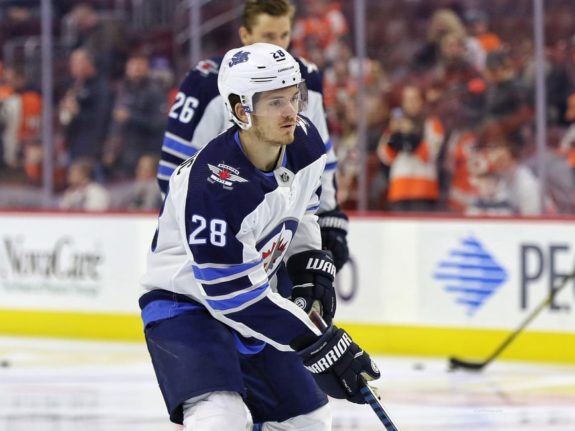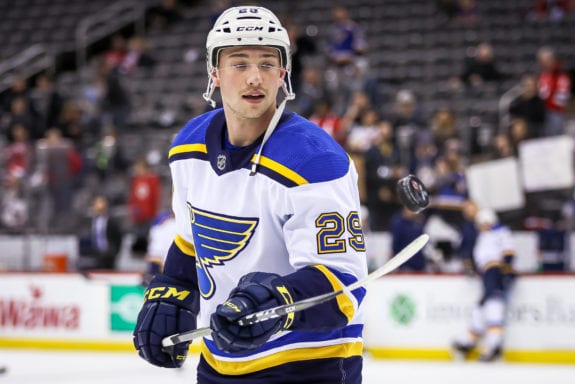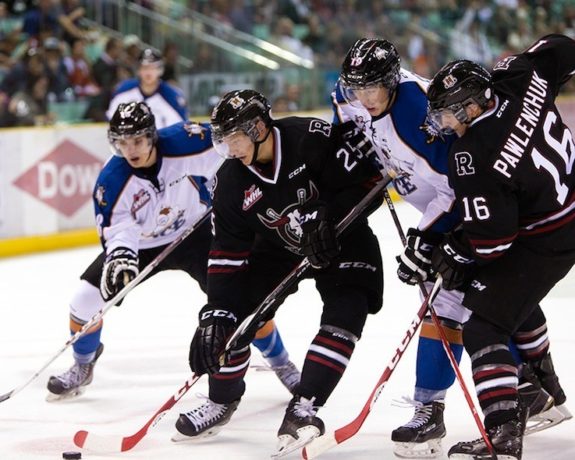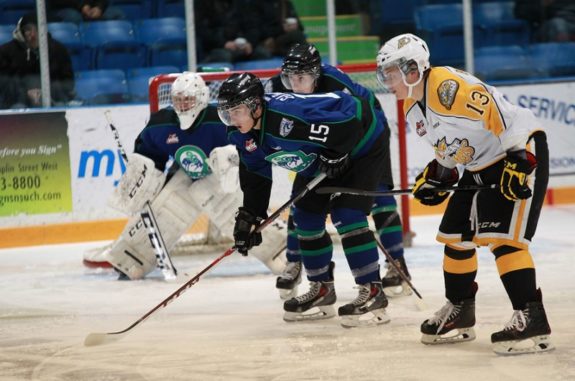We have been traveling back in time to revisit St. Louis Blues general manager Doug Armstrong’s draft record, and evaluate the claim that he is a strong drafter. For other entries in our series, view the index below:
- 2010: Two stars arrive
- 2011: Second round success
- 2012: A diamond in the rough
- 2013: A year to forget
- 2014: Success after success
- 2015: Dunn and done
- 2016: A lot of promise
- 2017: Stanley Cup foundation
As we move closer to the present day, there will be less certainty about what prospects might become; however, in 2015, the Blues acquired at least one player who looks to be a core piece for their long-term future.
First Round
First Round Pick (#22): Winnipeg Jets Select Jack Roslovic
Much like in 2013, the Blues entered the 2015 Draft without a first-round pick. They surrendered this pick to the Buffalo Sabres, when they traded the conditional first that became this pick, Chris Stewart, Jaroslav Halak, prospect William Carrier (2013 Draft), and a 2016 third-round pick in exchange for Steve Ott and goaltender Ryan Miller.
Miller’s tenure in St. Louis is not remembered fondly by Blues fans, as the move that was advertised as a Stanley Cup winner resulted in yet another first-round exit. Because Miller did not sign an extension with the Blues, the conditional first moved from 2014 to 2015. That pick subsequently moved to the Winnipeg Jets in the massive trade that brought Evander Kane and Zach Bogosian to the Sabres.
Thus, the Jets entered the 2015 Draft with the pick, and they selected Jack Roslovic, a promising American youngster from the U.S. National Team Development Program. He had 117 points in 90 games between two leagues in his draft year, and showed the upside of a late-round steal.

At just 22, Roslovic is still developing, and 2018-19 was his first full season in the NHL. He has not shown the scoring touch at the highest level yet, but he’s been limited to under 10 minutes per game. A brief stint in the top-six showed that the consistent scoring he found at every other level will translate to the NHL, he just needs to find the playing time.
For the Blues, Roslovic developing into a star would be the final nail in the coffin of the Miller trade. It was worth trying, but it is one of the least successful trades of Armstrong’s tenure. Miller never found his groove in St. Louis, and the package the team surrendered was a heavy price to pay for a failed experiment.
Middle Rounds (2-4)
Vince Dunn, D (Niagara IceDogs, OHL) #56
With their second-round pick, the Blues made up for the lack of a first rounder by selecting a critical player to their future. Vince Dunn was undersized, at a generous 6-feet and 185 pounds, but scouts raved about his offensive upside.
Dunn was described by various scouting reports as “a cerebral puck mover with offensive flair” who “possesses high-end, elite agility with insane lateral movement that he uses very effectively.” One report from the Black Book concluded “the vision this kid possesses is elite.”

Dunn fell in the draft due to his size, as well as some concerns about his defensive play. The Blues’ scouting group is high on hockey IQ, though, so he was a perfect fit for their philosophy.
It didn’t take long for him to arrive in the NHL, surprising many by making the team out of camp in the 2017-18 season. His rookie season was impressive, collecting 24 points in 75 games, though he did show some of the defensive inconsistencies that scouts had worried about.
The following season was Dunn’s coming out party. He was a team leader in Corsi for percentage, a measurement of possession, as well as relative Corsi, suggesting the team possessed the puck best when he was on the ice. He was also a team leader in point shares, a stat which measures a player’s contribution to his team’s place in the standings.
The future is bright for Dunn, who may well become an elite, puck-moving power-play quarterback in the NHL in the near future. He has even drawn comparisons to Duncan Keith. That is first-round value for a team without a first-round pick, and it was a great value pick for the Blues.
Adam Musil, C (Red Deer Rebels, WHL) #94
When head coach Todd McClellan moved from the San Jose Sharks to the Edmonton Oilers, the Blues’ third-round pick moved to San Jose. The Oilers had acquired this pick along with David Perron in a trade that sent Magnus Paajarvi and two picks back to the Blues. They then had to surrender the pick as compensation for taking on McClellan. The Sharks selected goaltender Mike Robinson, who has not yet played in the NHL.
One of the picks the Blues got in return was the Oilers’ fourth-round pick, with which they selected Adam Musil (the other pick was Ivan Barbashev the year before). Musil was a Czech Republic import to the WHL, where he played with the Red Deer Rebels. He showed some scoring ability in his draft season, but was most notable for his frame, at 6-foot-3, 203 pounds.

Musil would go on to score more with the Rebels, eventually becoming the team’s captain. Since arriving in the AHL, he has not showed the same scoring ability, but he has maintained his size, leadership, and physicality. He has yet to arrive in the NHL, but he could well be a character fourth-line contributor in future seasons.
Glenn Gawdin, C (Swift Current Broncos, WHL) #116
This pick could become a “one that got away” situation for the Blues. With their own fourth-round pick, St. Louis selected Glenn Gawdin, a 6-foot-1 center from the WHL. He showed some potential, and would go on to captain the Swift Current Broncos.
Unfortunately for the Blues, there comes a time when decisions need to be made about whether to keep a prospect in the organization. When that time came for Gawdin after the 2016-17, the team elected to let him become a free agent rather than sign him to a contract.
The Blues’ loss was the Calgary Flames’ gain, as they elected to invite Gawdin to training camp the following season, and later sign him to a contract. Motivated by the disappointment of an organization giving up on him, he transformed his game and more than doubled his previous WHL point total, collecting 125 points in 67 games. In the playoffs, he was third in the league in points while he captained the Broncos to a WHL Championship.

The following season, Gawden showed no signs of slowing with a strong performance with the Stockton Heat in the AHL. He is now looked at as a valued prospect in the Flames system. Only time will tell whether not signing him comes back to haunt the Blues in a major way, but given how he’s developed so far, it’s probably a decision they regret.
Late Rounds (5-7)
Niko Mikkola, D (Kalpa U20, Nuorten SM-liiga) #127
The Blues acquired this pick all the way back in 2013 when they traded Matt D’Agostini to the New Jersey Devils (he later re-signed with the Devils, which allowed St. Louis to receive this pick). With it, they chose Niko Mikkola, a towering Finnish defenseman. At the time, Bill Armstrong (no relation to Doug) was excited about the pick:
He’s still raw, but he loves to push the pace, loves to be involved. He’s a difference-maker with a big body type that can skate, so for us, we’re hoping that he turns out as well as [Colton] Parayko has.
Blues’ Director of Amateur Scouting, Bill Armstrong
Indeed he has developed well for a fifth-round selection. He spent 2018-19 in the AHL, his first North American season. There’s no telling if he’ll quite reach the heights that Parayko has, but he is near the top of the heap when it comes to Blues defensive prospects.
Luke Opilka, G (U.S. NTDP, USHL) #146
With their own fifth-round pick, the Blues selected a goaltender originally from the St. Louis Metro Area, Luke Opilka. He showed some promise with the U.S. development team before moving on to the Kitchener Rangers.
Unfortunately, he struggled with injuries in his career. After undergoing hip surgery twice to address hip dysplasia, Opilka decided to retire at the young age of 21. He is now healthy and attending college.
Missed Opportunity: Troy Terry, F, #148
We have not discussed many missed opportunities during this draft, as it’s tough to say what players will become with much certainty. But Troy Terry of the Anaheim Ducks is looked at as a very enticing prospect for the future.

He spent 2018-19 as a point-per-game player before receiving a permanent call up to the Ducks. Though his team looks like it has a rough patch of rebuilding ahead, they have a major piece in Terry, and the Blues missed out on him by just two picks.
Liam Dunda, LW (Owen Sound Attack, OHL) #176
In the sixth round, the Blues took another forward, Liam Dundy of the Owen Sound Attack. He was never a scorer, but his huge frame, at 6-foot-4, 212 pounds, must have appealed to the team. Unfortunately, he never developed much, and the Blues let him go the same day they released Gawdin. He’s since been in the QMJHL, the Greater Ontario Junior Hockey League, and with Queen’s University. Dunda was the Blues’ last selection, as they had traded their seventh-round pick as part of the D’Agostini deal.
Final Grade: Realized, C; Potential, B-
From here on, we’ll give two final grades: one for the realized impact of a draft, and the other for its potential. The ascension of Dunn and the future he has elevates this draft a little, but one good player does not an excellent draft make.
There is still potential for a few players to make an impact, namely Musil and Mikkola. Musil likely will never rise above a fourth-line role, if he makes the NHL at all. Mikkola may be a decent defenseman, but his lack of offensive output limits his overall potential.
Dunn is a special young player, and he certainly has the potential to become a true difference-maker at the NHL level, if he is not that already. But it just isn’t enough to consider this a great draft. It isn’t Armstrong’s worst, but he’s certainly had better days, too.